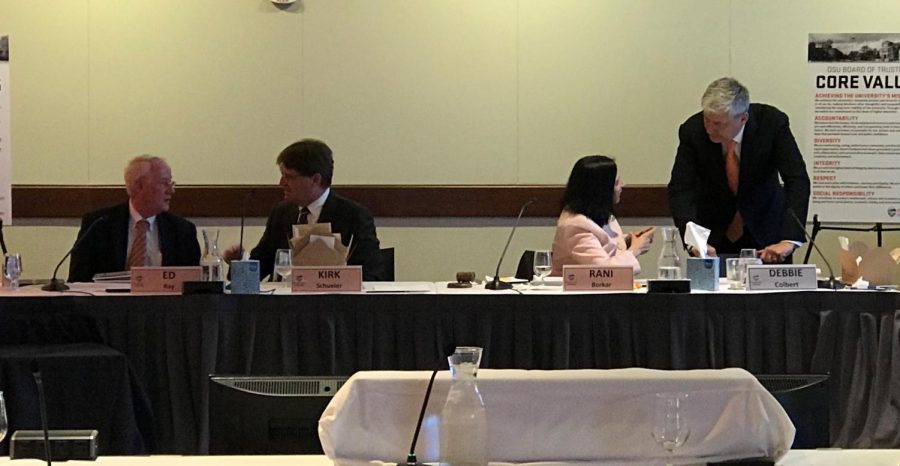OSU Board of Trustees approves tuition increase, announces plan for presidential search committee
April 5, 2019
The Oregon State University Board of Trustees approved an increase in in-state and out-of-state tuition for the 2019-2020 academic year and summer 2019 term. The board approved an increase of 4.29 percent for in-state undergraduates and 3.81 percent for out-of-state undergraduates, an increase of $405 and $1080 respectively.
The proposed rates assume that a combination of revenue from tuition increases, enrollment growth and expense reductions are the core components for a balanced budget in 2020. The Finance & Administration committee forecasted that the university would face a cost increase of $34.7 million for the fiscal year and that the recommended plan would increase revenue and reductions enough to balance the budget.
The increase in tuition is projected to increase revenue by $14.7 million, and it is expected to make up about 42 percent of the needed revenue and reductions for fiscal year 2020. The expense reductions are estimated make up another 36.6 percent needed for the balanced budget. These two components combined offset about 78 percent of expected cost increases.
State funding is expected to increase revenue by $2.8 million, only 8 percent of the revenue or reduction items needed to keep up with projected 2020 expenditures. The remaining 22 percent needed to balance the 2020 budget is estimated to come from enrollment growth and other funds.
Presidential Search
Zach Smith from the Board of Directors and Suzanne Teer, an executive search consultant in Witt/Kieffer’s Education Practice, will be a part of the search to determine who will take over OSU President Ed Ray’s position. Ray announced last month that he planned on stepping down as president in June 2020.
According to Smith, the most important part of the search is to engage all of the stakeholders in the process.
“We have talked about coming back to multiple sites on campus to have conversation with students, faculty, staff and community members to see what they want to see in the next president,” Smith said.
In late April and early May the Presidential Search Committee and Witt/Kieffer Team will host listening sessions with university and community members to communicate what characteristics they desire to see in OSU’s next president. Based on the community’s input, the Witt/Kieffer Team will submit a draft leadership profile, recruitment and advertising strategies and input from the Presidential Search Committee to the Board of Trustees for review. Once the Board of Trustees finalizes the profile the recruitment and candidate evaluation begins.
The next phase of national recruiting, screening and interviewing of candidates will be completed by the Presidential Search Committee during summer and fall. They additionally will select semi-finalists for more interviews and further reference checks. The committee will then prepare a report for the board chair, who will determine the candidates that will be presented to the Board.
By early winter, the candidates who moved forward to the second round will be interviewed by a group of university and community voters and the Board of Trustees. A survey with feedback from the constituents will be reviewed by the Board of Trustees. The Board will rank the candidates in a public session and consult with the Governor.
“Making sure we have a diverse committee with different representative views and different views on religion and ethnicity and other diversities is very important to me,” Smith said.
Following the interviews and negotiations the Board of Trustees votes to appoint the new president.











































































































